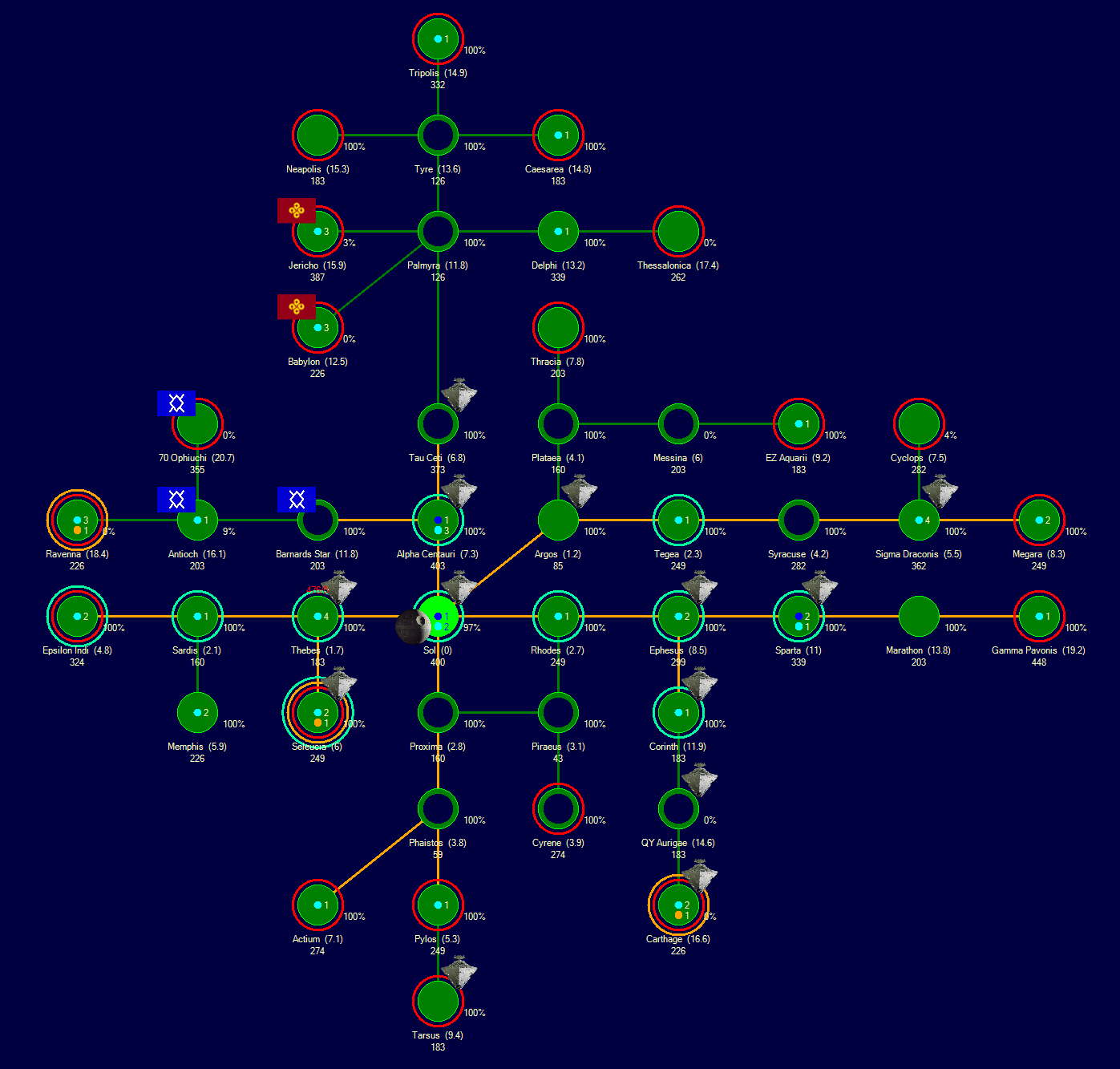On July 10th 1895, a new alien race was detected in the Antioch system. Antioch, an unremarkable red dwarf binary, was located two jumps beyond Alpha Centauri’s outermost jump point, via Bernard’s Star. The geological survey cruiser Scylla was surveying a cluster of Trojan asteroids associated with a superjovian that was the sole planet of Antioch-A. Six strength-120 thermal contacts, of three different types, were detected at three point six million kilometres, closing from the direction of the superjovian at 8745 km/s. Scylla engaged her Maxwell MX-36 Area Surveillance Sensor, but the contacts were too small to detect with the sensor’s resolution of 6000 tons.
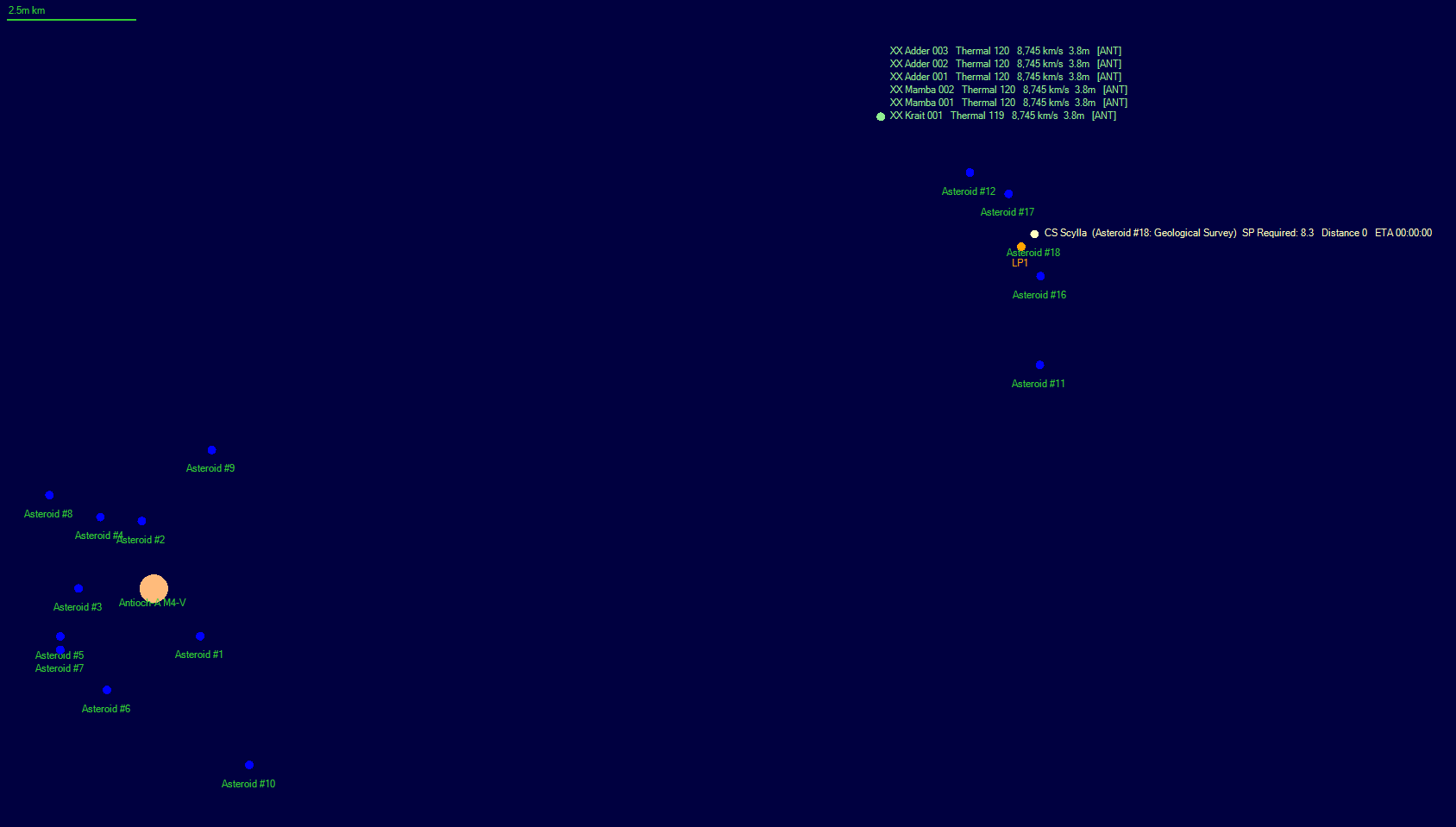
The recent gravitational survey of Antioch by Aeolus had revealed two jump points, leading to Ravenna and 70 Ophiuchi. Aeolus had already moved into Ravenna to begin a new survey, while the jump tender Hyperion was on the Antioch – Ravenna jump point to maintain a communication link. Commander Benjamin Hurst on the Hyperion was the senior officer present to he ordered Aeolus to pull out of Ravenna and both survey cruisers to head for the Bernard’s Star jump point. His own ship set a course for the same jump point, where he intended to wait for the survey cruisers while monitoring the situation. The C.O. of Scylla, Commander Nicholas O’Connor, requested permission to fire on the fast-closing contacts as soon as he could establish an active lock. Commander Hurst ordered him to hold fire unless fired upon. The Empire was already facing one hostile alien race, so Hurst did not want to accidentally add a second. Instead, Scylla hailed the alien ships. There was no response.
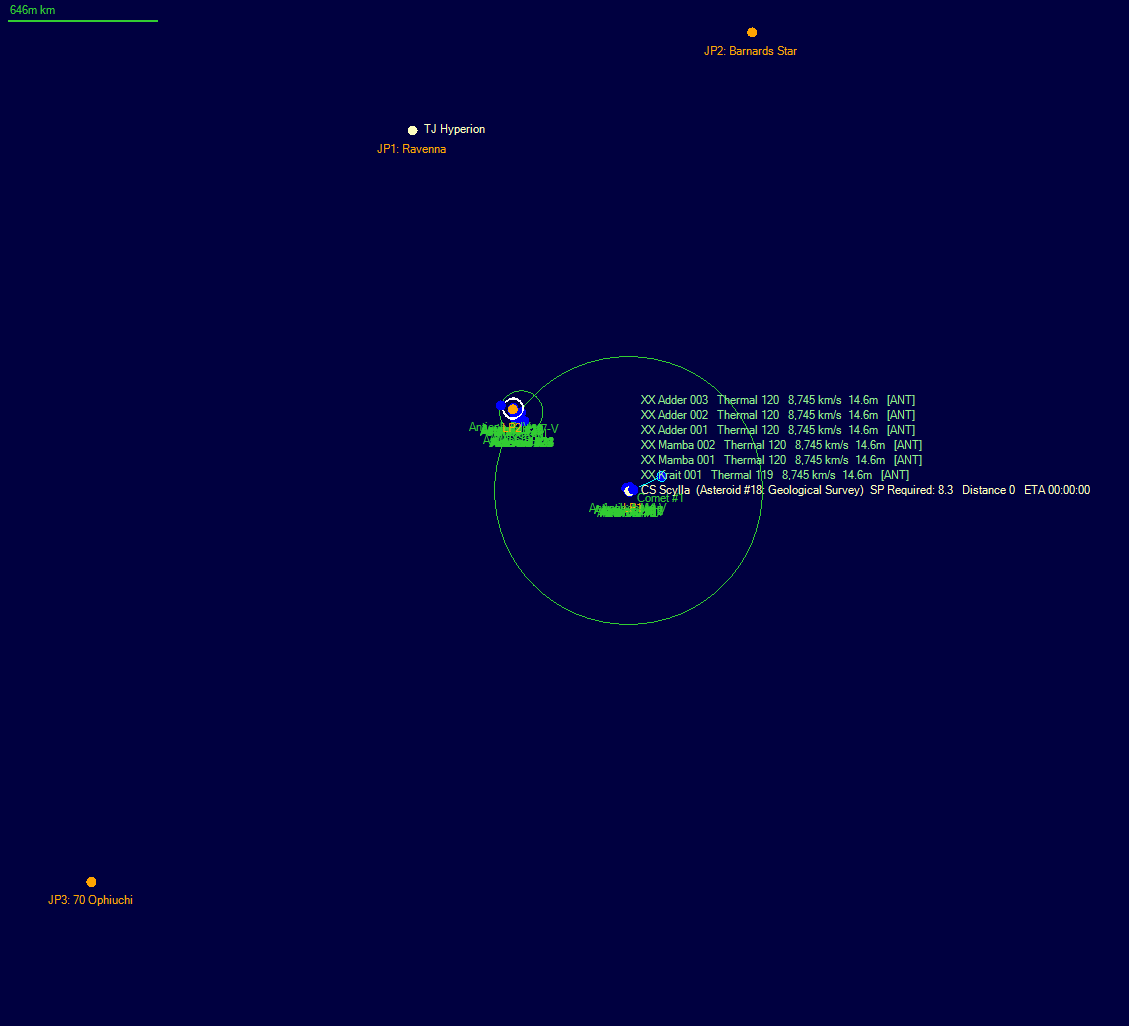
Scylla moved to the nearby Lagrange point in the midst of the Trojan asteroids and jumped to the Lagrange point of Antioch-B III, one of four planets orbiting the companion star. Seven minutes later, the six alien ships also jumped to the Antioch-B III Lagrange point, a million kilometres from Scylla, and continued closing. Ninety seconds after the aliens jumped, Scylla picked them up on active sensors at 440,000 km. With Aeolus in Ravenna and encountering no sign of an alien presence, the likely origin of the aliens was the 70 Ophiuchi jump point. Given that star was part of the constellation of Ophiuchus, the serpent-bearer, the alien ship classes were assigned the names of snakes. Three were Adder class, two were Mambas and the third a Krait. The Krait was 678 tons and had an active strength-63 sensor, while the Mambas and Adders were 686 tons and one of the Mambas had an active strength-21 sensor. Both the Krait and Mamba sensors had a resolution similar to that of Scylla. Given that Scylla’s own 150 ton Maxwell MX-36 was a strength-36 sensor, it seemed that the Krait could be little but a sensor and an engine, while the Mambas had some other capabilities. There were no active emissions from any of the Adders so information on them was limited to size and speed.
Once again, Commander O’Connor requested permission to fire, citing the aggressive approach of the alien ships. The alien sensors were obviously capable of scanning his ship from a far greater distance and there was no attempt to communicate. There seemed little reason to close to a few hundred thousand kilometres, except to fire some form of energy weapons. His superior, Commander Hurst, had joined the Royal Navy due to an interest in science, particularly astronomy, and a desire to work with the latest technology. He had not expected to be placed in a potential combat situation. Precious seconds ticked by as he prevaricated. In contrast, Commander O’Connor was a consummate professional with a history of taking calculated risks. Unfortunately, with Hyperion on the Ravenna jump point, there was no direct link to the Admiralty so O’Connor could not request confirmation from higher authority. Also, due to her recent mission to Jericho, which required a load out heavy on sensor drones, Scylla had only ten Perseus torpedoes.
Commander O’Connor was convinced the aliens meant to attack and could not wait any longer for Commander Hurst to make a decision. He ordered his tactical officer to target one of the Adders and open fire. Two Perseus torpedoes streaked toward the target as Scylla’s fire control targeted a second Adder. Due to the high speed of the target, the 19,200 km/s torpedoes had approximately a 23% chance to hit. As the missiles closed in, the alien ships suddenly reversed course and began heading directly away from the survey cruiser. Attacking an alien ship that was heading away from his own, without committing any hostile action, was far less likely to be approved in retrospect by the Admiralty, so Commander O’Connor gave the order for the two torpedoes to self-destruct. Only eight Perseus torpedoes remained. The six small alien ships continued to move away, passing the Lagrange point without jumping, and vanished from thermal sensors at three point six million kilometres. Scylla continued on course for the jump point. Aware that his own hesitance had contributed to the tense situation, Commander Benjamin Hurst refrained from relieving O’Connor from command and instead informed his subordinate that he would submit a report and let the Admiralty decide how to deal with him.
Meanwhile in Alpha Centauri, Commodore Marcus Bowen led his original Palmyra squadron, comprising the heavy cruisers Ariadne and Niobe and the light cruisers Pegasus and Perseus to the new Toliman colony following shore leave and an overhaul at Earth. The ships that had replaced them in Palmyra headed back to Earth for resupply and their own overhauls. By this point, the Toliman colony had twenty maintenance facilities, with a combined capacity of thirty-two thousand tons, plus a refuelling station. The replenishment ship Resurgent was stationed in orbit, after completing a mission to transport fuel, supplies and ordnance to the Leonidas colony in Sparta. The picket in Palmyra was reduced to the tanker Thesmophoros, which would be relieved by Selene when the jump tender returned from supporting Spartan in Neapolis.
Scylla transited into Bernard’s Star on July 18th, eight days after the alien encounter. Hyperion, with a top speed of 1523 km/s, was still in Antioch, eighty-seven hours from the Bernard’s Star jump point, while Aeolus had yet to emerge into Antioch from Ravenna. Scylla encountered a Hera class stabilisation ship in Bernard’s Star, working on the Antioch jump point. The ship had already stabilised the Bernard’s Star – Alpha Centauri jump point so Scylla was able to transit a warning directly to Earth. The Admiralty instructed the Hera to abandon its task and head back to the Sol system. Scylla was ordered to transit back into Antioch and hold position on the jump point, monitoring for any alien ships, until Hyperion arrived, at which point Scylla would head for Earth while Hyperion assumed the picket duty. The Admiralty did not want to divert Commodore Bowen’s Alpha Centauri squadron, as it still had to guard against an incursion by the Babylonians, so a new squadron, comprising the Diadem class cruisers Andromeda and Amphitrite and the Pelorus class light cruisers Pioneer and Psyche, was formed from the Home Fleet and dispatched to Bernard’s Star.
Two days after Scylla transited back into Antioch, she detected a large alien formation comprising twelve Mambas, six Adders, three Kraits and twelve of a new type designated as Anaconda. The alien fleet was at three point six million kilometres and closing directly on the jump point at 8745 km/s. The new formation did not include any of the six original ships. Given that the jump point was over two billion kilometres from the previous point of contact, Commander O’Connor did not believe the aliens had simply stumbled across him. The more likely scenario was that the small formation of six ships, including one with a capable active sensor, had pulled back to long range and shadowed his ship across the system while summoning reinforcements. If that was true, it was also possible they had detected his brief transit into Bernard’s Star and learned the location of the jump point.
O’Connor transmitted a warning to Commander Hurst on the Hyperion, still thirty-six hours from the jump point, then took Scylla into Bernard’s Star to warn the Admiralty. With eight torpedoes in his magazine and thirty-three alien ships, there was no question of fighting. The Admiralty quickly confirmed his request to retreat, although they ordered him not transit into Alpha Centauri in case alien forces monitored the jump and learned the location of the jump point. It was possible the alien formation was not jump capable, but the Admiralty was not taking any chances. Hyperion had little option but to continue toward the jump point and hope the aliens were friendly, while Aeolus was still in Ravenna and unaware of recent developments. Sir Frederick Richards was also concerned about the combat potential of almost forty high speed ships with an assumed total tonnage of around 27,000 tons, although the Anacondas had not been detected on active sensors. As the first three Majestic class battleships, Majestic, Magnificent and Victorious, had recently been delivered to the Home Fleet, he authorised the Royal Sovereign class battleships Repulse and Resolution, along with the lead ship of the Pelorus class, to head for Alpha Centauri.
At 14:15 on July 21st, as Hyperion moved within three point eight million kilometres of the Antioch – Bernard’s Star jump point, she detected active sensor emissions from two Krait class ships waiting at her destination. Almost at the same moment, the alien ships left the jump point and began heading straight toward Hyperion. Thermal signatures were immediately detected, confirming this as the same thirty-three ship force that was detected by Scylla. Hyperion could not outrun the aliens so she continued on course for the jump point and tried to hail the alien ships. As before, there was no response. The alien ships closed in on a reciprocal heading with the range dropping by more than 10,000 km every second. At 102,000 kilometres, the six Adders opened fire with some form of energy weapon. Five scored strength-1 hits, blowing holes in Hyperion’s thin armour. Five seconds later, the Adders fired again inflicting strength-2 hits and causing further armour damage. The twelve Mambas joined the battle, using some form of microwave weapon that passed through Hyperion’s armour and wreaked havoc on her electrical systems. The jump tender’s active, thermal and EM sensors were all disabled, leaving her completely blind.
Enemy fire ceased. Any thoughts of a reprieve were dashed when hostile boarders came streaming in through the holes in Hyperion’s armour. The aliens were multi-limbed monstrosities, scuttling forward on a pair of hooved, backward-jointed legs. An upper pair of limbs served as curved, bladed weapons, while smaller, secondary limbs disgorged bolts of acid. Hyperion had a crew of three hundred and forty, the vast majority of which were required for her fourteen commercial engines and her massive jump drive. The crew reached for side-arms they never seriously expected to need and a brutal, chaotic battle ensued. The invading aliens were outnumbered, with perhaps two hundred on the ship, but their weapons cut straight through the crew’s minimal armour and they were covered by a hard exoskeleton that was very resistant to the crew’s light weapons. Even on the rare occasion that a shot did penetrate, the alien creatures shrugged off the hit and kept coming. Forty-five of the crew were dead within the first minute of the battle, with no loss to the alien combatants.
In the midst of the battle, acid began burning through the hull. This was not a new attack but an after-effect of the earlier shots from the Adders that had damaged the armour. The alien weapon had both an immediate impact effect and a residual burn-through effect. One of the ship’s engines was disabled by the acid, slowing Hyperion to 1,414 km/s. Even at the slightly reduced speed, the jump point was less than forty minutes away. However, given the ineffectiveness of the crew’s weapons, it seemed very unlikely they could last that long. Two minutes after the boarding began, the acid burn-through wrecked the jump drive. Despite the desperate situation, those of the crew that could be spared began repair attempts. The fighting on the engineering deck was also inflicting damage on the engines, although so far they remained operational.
One of the invaders was finally killed by a lucky shot through an eye socket. So far, the crew had scored more than a hundred and thirty hits on the aliens, with five shots penetrating their exoskeletons and only a single alien down. Over a hundred and forty crew were dead. Ninety-one in the fighting and the rest killed by the destruction of the jump drive and the engine. The battle was rapidly becoming a slaughter and the aliens were not interested in taking prisoners. Less than ten minutes after the aliens stormed on to the Hyperion, the last crewman was hunted down and killed. Commander Hurst died with his crew defending the bridge. The rest of the Empire was completely unaware of the fate of Hyperion, the strength of the alien weapons and the alien boarding capability.
The survey cruiser Aeolus entered Antioch from Ravenna on July 29th, eight days after the loss of Hyperion and nineteen days after her last contact with another Empire ship. Her C.O., commander Patrick Nixon, had been informed on July 10th that Scylla was in contact with six small alien ships and that Scylla, Hyperion and his own ship were all withdrawing to Empire space. From his perspective, he believed that both Scylla and Hyperion had already transited the Antioch – Bernard’s Star jump point, so he proceeded on that same course. In the early hours of August 5th, Aeolus reached the jump point without detecting any alien ships and transited into Bernard’s Star.
Within seconds of the transit, Aeolus came under fire, taking two strength-3 hits from energy weapons and three strength-2 hits from microwave weapons. The energy weapons cut through the survey cruiser’s armour and destroyed the jump drive. The microwaves bypassed the armour, disabling all three survey sensors, the EM sensor, the MX-36 active sensor and the missile fire control. Even if Aeolus wasn’t suffering from jump shock, she couldn’t target her missiles without the active sensor or the fire control. Thermal sensors were operational and detected the six alien ships that were originally encountered by Scylla. The latter ship was still in Bernard’s Star, located three billion kilometres away on the Alpha Centauri jump point. A Hera class stabilisation ship was also in the system, midway between the jump point and running at 1256 km/s.
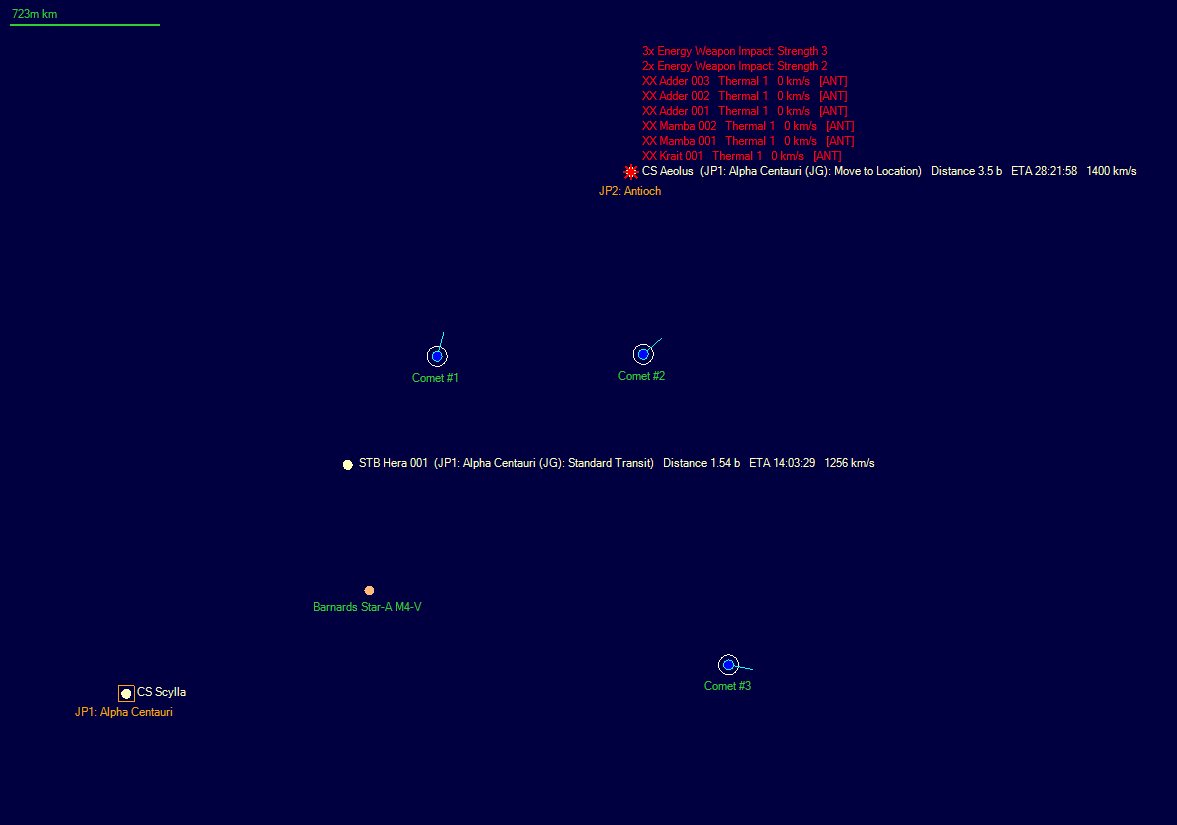
The Admiralty had been concerned about Hyperion, given she was two weeks overdue for her arrival in Bernard’s Star. The attack on Aeolus as she transited into the system only confirmed their worst fears of Sir Frederick Richards. Within seconds the alien ships fired again, destroying one of Aeolus’ two Parsons PN-250E Triple Expansion Ion Drives, disabling the thermal sensor and blasting a hole in the fuel storage. The survey cruiser was slow and blind and not even capable of retreating through the jump point. The microwave weapons had no more targets to hit, but the two energy-armed Adders continued to fire, with each strength-3 shot penetrating the armour and inflicting internal damage. Aeolus attempted to pull away toward the Alpha Centauri jump point, but even that desperate action came to nought when the remaining engine was disabled.
Twenty seconds after transit, Aeolus was completely helpless, with eighty of her crew already dead and no way to move or fight. Commander Nixon gave the order to abandon ship. The remaining one hundred and fifty-one crew escaped in the life pods and the ship self-destructed. Unfortunately, there was no way to reach the survivors. Scylla could move from the Alpha Centauri jump point to the Antioch jump point in fourteen days, but had only eight torpedoes remaining. Two Diadem class cruisers and two Pelorus class light cruisers would arrive in Bernard’s Star in thirteen days with two Royal Sovereigns and a third Pelorus two days behind them, but they would still have to travel across the system. While the fate of the survivors was a serious concern, a far greater strategic problem was that hostile aliens were just two jumps from Sol and both those jumps points had been stabilised.
By August 19th the Bernard’s Star Squadron of two battleships, two heavy cruisers and three light cruisers, under the command of Captain James Sanderson, was in position on the Bernard’s Star – Alpha Centauri jump point. Scylla remained to provide jump support for the smaller ships should they wish to enter Antioch, while the Hera class stabilisation ship had safely transited into Alpha Centauri. The squadron was below fifty percent fuel, so if they preceded any further they would run very low. The replenishment ship Resurgent was en route to Bernard’s Star, but would not arrive for thirty-eight days. The Alpha Centauri Squadron of two heavy cruisers and two light cruisers remained in orbit of the Toliman colony, guarding against any incursion by the Babylonians. The Home Fleet, in Earth orbit, comprised three Majestic class battleships, six Royal Sovereign class battleships, three Diadem class heavy cruisers and four Pelorus class light cruisers. The heavy cruiser and light cruiser that formed the Sparta Squadron were in orbit of the Leonidas colony.
The life pods of the Aeolus still had life support, although failure was imminent. As the Resurgent was bringing both fuel and a limited supply of ordnance, Captain Sanderson decided to attempt a rescue and in the process clear the aliens out of Bernard’s Star. Sanderson was an aggressive commander, although recently in poor health which made him impatient to accomplish his task before his condition grew worse. The squadron headed directly for the Antioch jump point at 4000 km/s. Scylla followed in the squadron’s wake at 2800 km/s. The squadron was halfway to the jump point when the pods’ life support expired.
The Empire ships drew closer to the jump point, with all active sensors shot down except the Maxwell MX-10A Torpedo Warning Sensor on the light cruiser Pelorus. The MX-10A had a resolution that would detect the small craft at its maximum range and did not have a large signature that would be detected by alien EM sensors. At nine point seven million kilometres, the small alien ships were detected close to the jump point. The battleships Repulse and Resolution each fired twelve Perseus torpedoes with each salvo split between two targets. The Perseus was a short-ranged version of the standard Theseus torpedo with a fifty percent larger warhead. The Diadem class cruisers Andromeda and Amphitrite each targeted a single alien ship with eight Theseus torpedoes.
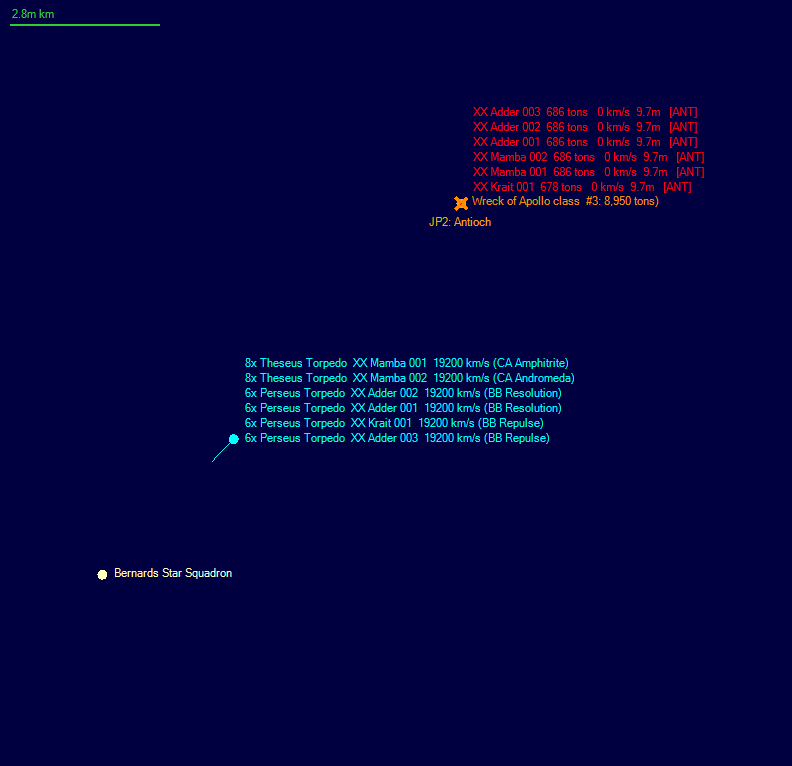
With the Empire torpedoes half way to their targets, the alien ships suddenly transited the jump point into Antioch. The torpedoes had no targets to track and no on-board sensors that could search for new targets, so all forty self-destructed. The squadron had no way to pursue because Scylla had the only jump drive in the system and was more than five days from the Antioch jump point. Even if they could pursue, they would be jumping into an unknown situation. Although Aeolus had not encountered any alien ships on her passage across Antioch, over three weeks had passed since then, so the other thirty-three ships detected by Scylla before she left the system could be waiting in ambush. Given the close-range capabilities of the alien microwave weapon, even Captain Sanderson’s aggression was tempered by the potential for disaster. For now, he ordered his ships to close to within five million kilometres of the jump point and hold position.
The Naval Intelligence Department of the Royal Navy classified the four known alien ship classes, the Adder, Anaconda, Krait and Mamba, as fast attack craft. This was based on their size of less than 700 tons, although only the Adder and Mamba had been observed in combat. The boarding action mounted against Hyperion was unknown to the rest of the Empire. The NID also officially assigned the new aliens a name - the Ophidians. This was due to their suspected origin in 70 Ophiuchi, plus it matched the assigned nomenclature for their ship classes.
On September 2nd, four days after the Ophidians left the system, six new alien ships of three new classes transited into Bernard’s Star. The smallest was the Viper class, with three ships of 11,222 tons. The two ships of the Python class were 22,189 tons, larger than the new Majestic class battleship. The largest was the sole King Cobra at a colossal 66,846 tons. The Bernard’s Star squadron was out-massed by more than two to one. There was no longer any need to be close to detect the alien ships, so Captain Sanderson ordered his ships to pull away at their maximum speed of 4000 km/s and fire a single salvo at one of the smaller ships. Sanderson was concerned that if the alien fleet faced several salvos it would simply retreat through the jump point and the missiles would be wasted, although given the balance of forces he wondered if that was the best outcome for his own force. Even as the torpedoes were launched, the alien fleet began moving toward them at 5700 km/s.
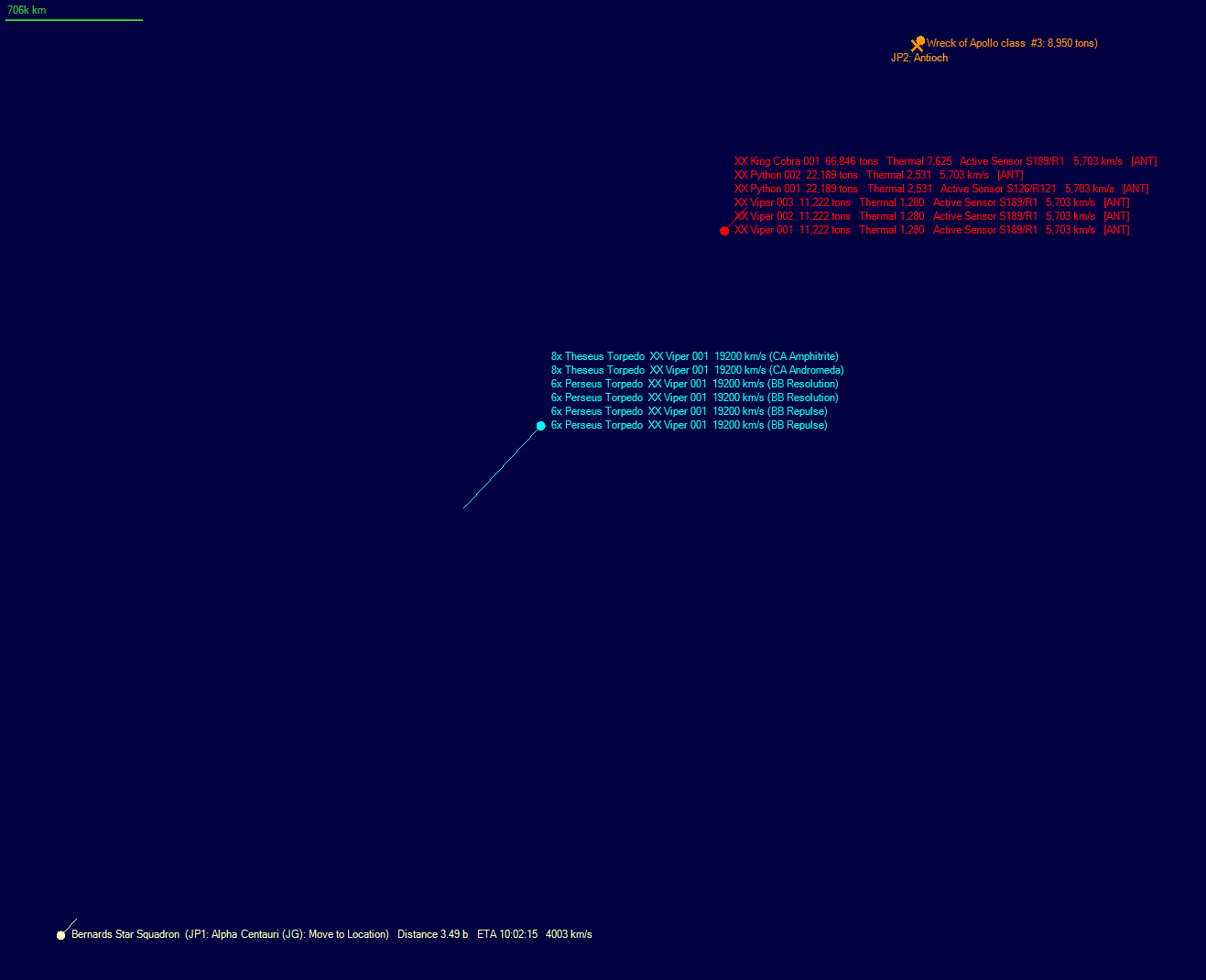
Captain Sanderson was well aware that the missile attack on the Babylonians two years earlier had been defeated by anti-torpedo torpedoes, so he was expecting something similar from the Ophidians. His hopes rose as the torpedoes drew closer and closer to the oncoming fleet without any sign of counter-fire. Just before the torpedoes were about to intercept their target, all forty were destroyed by a hail of energy weapon fire. Sanderson realised his fleet was suddenly in a very difficult situation. The Ophidian fleet was faster than his own and equipped with a defensive armament that could withstand an Empire torpedo attack. The Alpha Centauri jump point was three point five billion kilometres away and any potential reinforcements were weeks away.
The three Pelorus class light cruisers could contribute to the fight and their Daedalus AT torpedoes were faster and harder to shoot down. However, the Daedalus was short-ranged, with only a strength-1 warhead, and their higher speed meant they could not be launched in coordinated salvos with the larger Theseus torpedoes. The other option was to scatter the fleet in the hope that some ships would escape. Sanderson knew if he took that option, he had to do it as soon as possible. If he waited to see the effectiveness of the Daedalus AT torpedoes before scattering, more ships could be lost.
Although the Empire lacked any energy-armed warships and was still conducting background research into energy weapon technologies, a 10cm laser had recently been developed for ground forces to defend planets against hostile torpedoes. That laser could fire every five seconds so Sanderson suspected the Ophidian weapon probably had a similar rate of fire. Which meant the Theseus and Daedalus torpedoes had to attack together to have any chance of overcoming the point defence and causing significant damage. Given different speeds and launching rates, plus inexperienced crews that would struggle to coordinate with each other effectively, that would be very difficult to achieve. The other consideration was that the alien fleet appeared to have generally superior technology, based on its speed, so its armour was likely to be equal or better than the Royal Navy ships. So even if some missiles did penetrate the alien defences, it was unlikely they would be enough to destroy warships massing close to one hundred and fifty thousand tons.
The Alpha Centauri – Bernard’s Star jump point was stabilised, which allowed Captain Sanderson to confer directly with the Admiralty. While his instinct was to fight, rather than flee, he believed his best chance of getting as many crewman home as possible was to scatter the fleet. Sir Frederick Richards had been monitoring the engagement and immediately accepted Sanderson’s recommendation to scatter. It was possible the Ophidians would split their fleet, but that would also weaken their anti-torpedo capabilities. The order was given and the seven ships of the Bernard’s Star squadron headed away in different directions. The alien fleet adjusted course to intercept the battleship Repulse, so the Empire ships made their own adjustments.
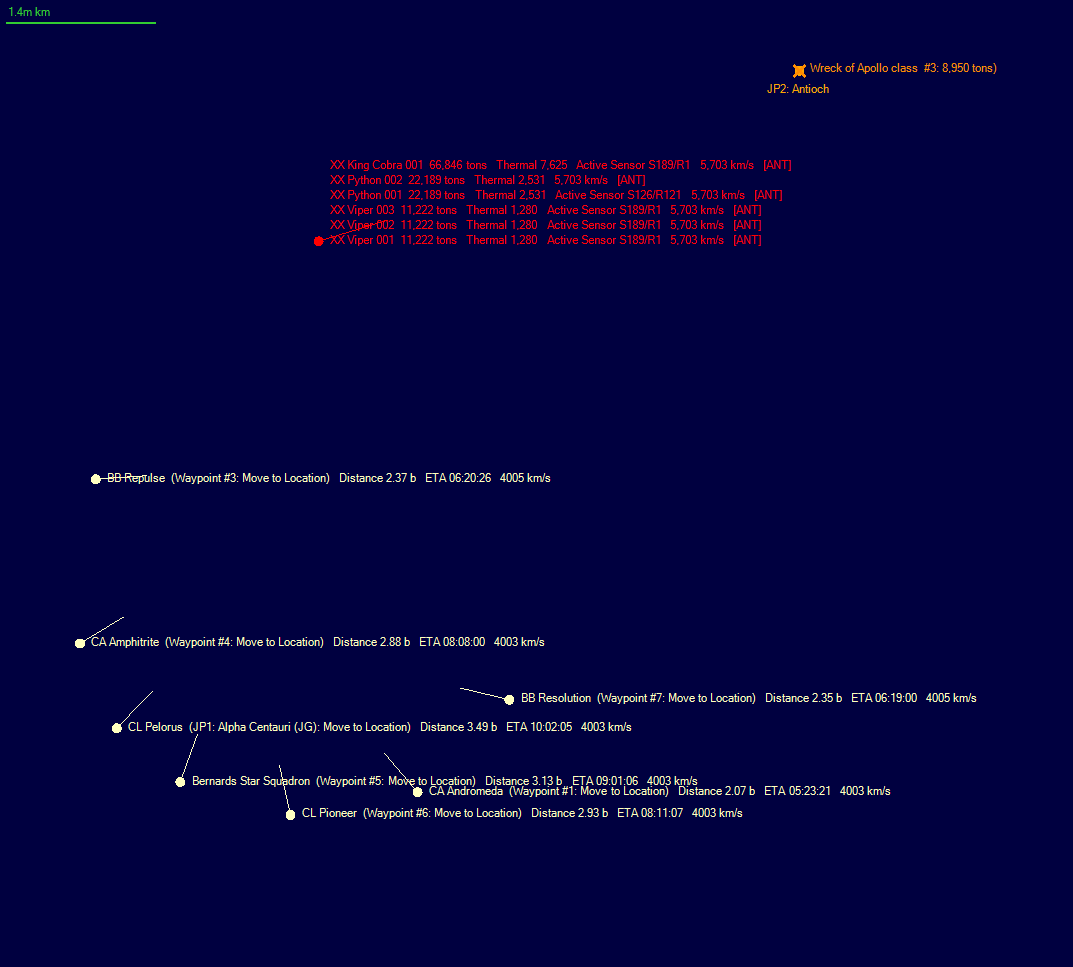
As the Ophidians closed in on Repulse, the battleship began launching torpedoes. While there was minimal chance of penetrating the enemy point defence, there was no point leaving them in the magazines. One hundred and sixteen torpedoes were launched at the alien fleet and every one was destroyed by energy weapon fire. The Ophidians closed in and opened fire at 318,000 kilometres. The two mid-sized ships, designated as Python class, each fired fourteen times and the largest ship, King Cobra class, just twice. All the shots missed, presumably due to the extreme range. Twenty seconds later the two Pythons fired again at 280,000 kilometres, although with twelve shots each rather than fourteen. Repulse suffered two strength-2 hits. After a further twenty seconds, the King Cobra and the Pythons reverted to their initial firing pattern. Repulse was struck by a strength-7 hit, which was very concerning at the range of 242,000 kilometres, and four strength-3 hits. As the range fell, the alien fire become more accurate and more damaging and the battleship’s armour was blasted away.
There was also an unexpected secondary effect to the damage. Earlier hits were still causing damage as some form of acid burned deeper into the armour at the central point of impact. Hyperion had encountered the same effect but had been unable to communicate that to the rest of the Empire. Eighty seconds after the first shots, with the range at 166,000 kilometres, Repulse was rocked by two strength-11 hits and eleven strength-4 hits. The armour was penetrated in several places and internal systems suffered significant damage. Two of the battleship’s four engines were destroyed, along with her primary sensor, a fire control, fuel storage and one of the magazines. Her commander considered ordering his crew to abandon ship, but the further the battleship could run, the more chance the other ships of the squadrons could escape. Twenty seconds later, Repulse suffered eighteen strength-9 hits and exploded. Fifty-six of her three hundred and seventy-one crew escaped to the life pods.
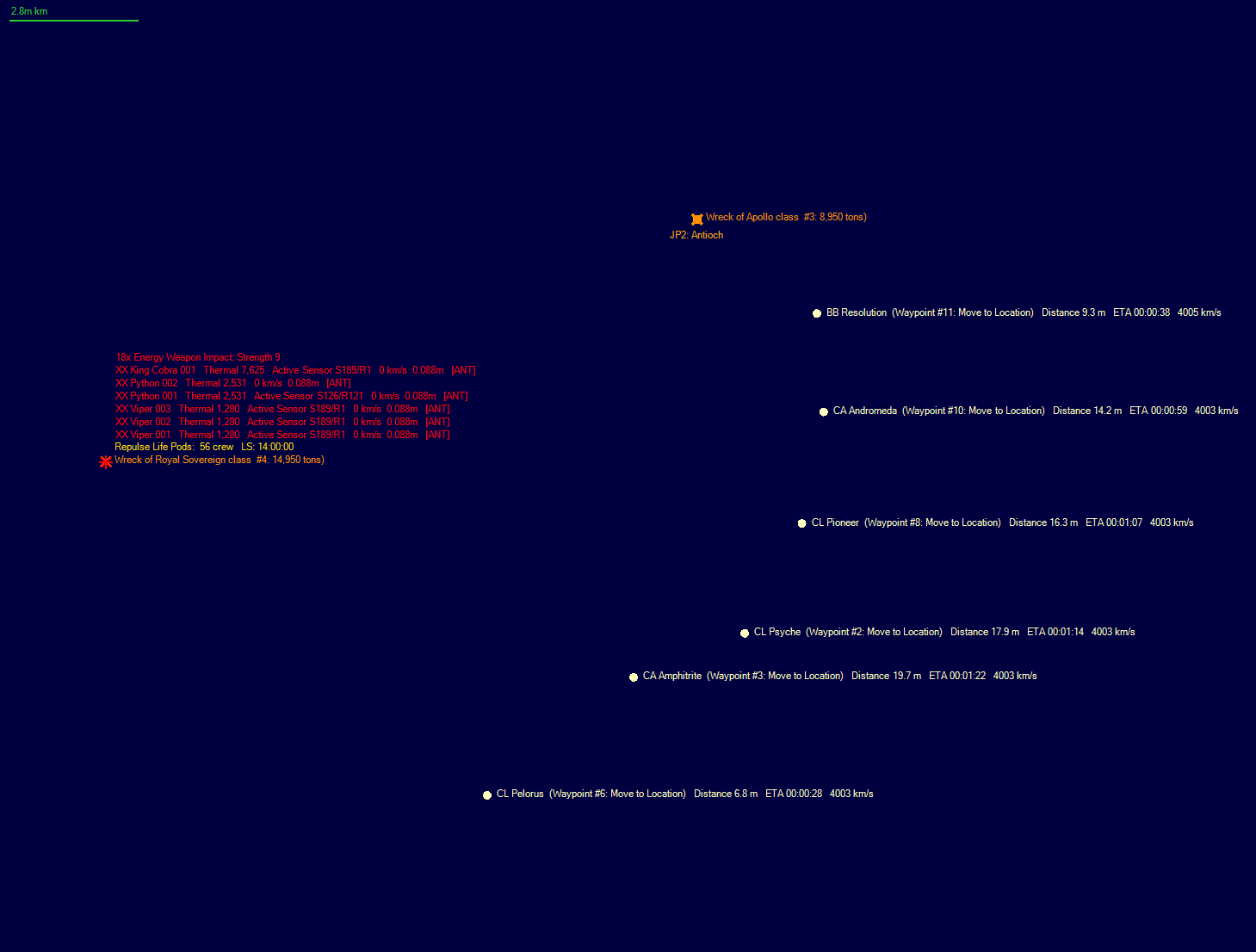
The other six ships of the Bernard’s Star squadron had opened the range to between eleven and sixteen million kilometres. The Ophidian fleet came about and set a pursuit course for the second battleship, Resolution, which was the furthest ship from the aliens. Despite the longer range, the aliens presumably saw the 15,000-ton battleship as a greater threat than the closest ship, the 6000-ton light cruiser Pelorus. Occasionally, the alien fleet would change course to threaten one of the other fleeing ships, causing a flurry of activity, then return to its pursuit of Resolution. Two and a half hours after the destruction of Repulse, Resolution began launching her torpedoes with the alien fleet at one point six million kilometres. No hits were scored. The Ophidians closed in and started pounding the Royal Navy battleship. The brief engagement was shorter than expected due to a strength-68 secondary explosion when an engine was destroyed. Resolution was blown to pieces.
Five ships of the squadron remained, although they represented just over half of the original tonnage. The closest ship to the Ophidian fleet was Andromeda, flagship of Captain Sanderson at of forty-eight million kilometres. The other ships ranged from Pioneer at sixty-six million to Pelorus at eight-six million. Only Andromeda had her active sensors engaged, as she was the only ship who with sufficient sensor range to detect the Ophidians. As she was the closest and equal largest ship, it was no surprise when the aliens turned to pursue her. Captain Sanderson took his ship across the projected course of the Ophidians, trying to draw them away from the other four ships.
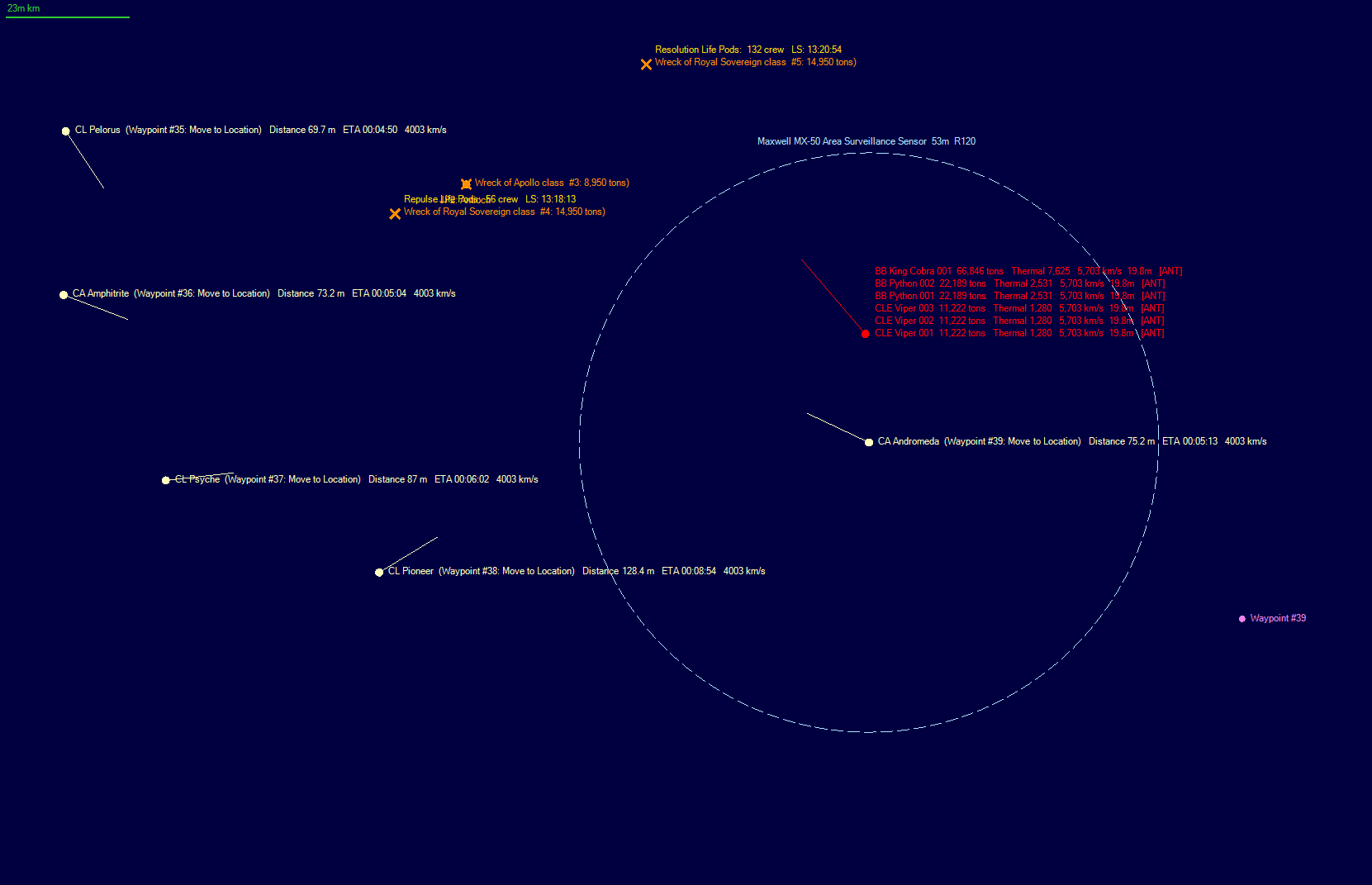
Andromeda waited until the aliens were at 700,000 kilometres before launching her torpedoes and was still launching when she came under fire. The desperate tactic had no more success than previous launches. Andromeda was destroyed at 06:41 on September 3rd, five hours after Resolution. Captain Sanderson and fifty-six crew survived from the complement of two hundred and forty-one. At the time of her destruction, the closest Royal Navy ship was the light cruiser Pioneer, at one hundred and forty-four million kilometres. That was almost three times the range of the most capable Royal Navy sensor. Whether it was greater than the range of the best Ophidian sensor remained to be seen. With the destruction of the Andromeda, the alien fleet could no longer be tracked, so the remaining four ships continued to move apart. Ahead of the fleeing warships, Scylla was on course for the Alpha Centauri jump point.
A full day passed without incident and then a second, as the heavy cruiser Amphitrite and light cruisers Pelorus, Pioneer and Psyche continued to run on diverging courses. On the third day after the destruction of Andromeda, Pioneer caught and passed Scylla. Conscious that all the ships were short on fuel, Sir Frederick Richards ordered them all to abandon their current courses and head for the Alpha Centauri jump point. Regrettably, that order meant the abandonment of the two hundred and forty-four crew in life pods in the area around the Antioch jump point. Captain Sanderson’s moral fortitude in ordering his ships to scatter and run, rather than engage in a futile fight to the death, had saved four ships and their crews. Any rescue attempt would only negate the sacrifices of the battleships Repulse and Resolution and the heavy cruiser Andromeda. Sanderson himself was in contact via the life pods’ comm system and was adamant that no ship should be risked to mount a rescue. The Ophidians apparently had no interest in recovering the survivors.
Pioneer transited into Alpha Centauri on September 13th 1895 with eleven percent of her fuel remaining. Psyche was eight hours behind her. Pelorus transited on September 14th, followed by the survey cruiser Scylla on the 16th. The heavy cruiser Amphitrite ran out of fuel three hundred million kilometres from the jump point. She would be stranded for two weeks until the arrival of the replenishment ship Resurgent. Eighteen hours after Scylla transited into Alpha Centauri, the bridge crew of Amphitrite noticed that the wreck of Andromeda had disappeared. It was only thirteen days since her destruction so the most likely explanation was that an Ophidian salvage ship had been waiting on the Antioch side of the jump point for the conclusion of the battle.
Resurgent arrived in Bernard’s Star on September 26th and moved to rendezvous with Amphitrite. They were more than three billion kilometres from the site of the recent battle and there had been no sign of any Ophidian activity beyond the disappearance of the wreck. After refuelling, both ships headed for Alpha Centauri. Just before transit on October 2nd, the wreck of the battleship Resolution vanished from sensors. Pelorus, Pioneer and Psyche were still stationed at the Alpha Centauri – Bernard’s Star, so Resurgent refuelled the light cruisers before heading toward the Toliman colony in the Alpha Centauri-B system. Psyche remained at the jump point as an early warning picket, until she could be relieved by a ship more suited to the task. Amphitrite, Pelorus and Pioneer also headed for the Toliman colony to reinforce the Alpha Centauri Squadron.
There was no longer any Royal Navy presence beyond the Alpha Centauri – Bernard’s Star jump point and that would remain the case for the foreseeable future. The Battle of Bernard’s Star was a severe shock to the Royal Navy and the Empire. Two battleships and a heavy cruiser had been lost, in addition to the survey cruiser Aeolus and the jump tender Hyperion, without even damaging their foe. The energy-based point defence of the Ophidians was formidable, they possessed capable long-ranged offensive energy weapons with an acid-based after-effect and they had a microwave weapon that disabled sensors and fire controls. Unlike the Babylonians, who so far seemed hostile but passive, content to hold their fleets in the territory they claimed, the Ophidians were extremely aggressive.
From the available evidence, it seemed that Ophidian knowledge of the Antioch – Bernard’s Star jump point was gained via monitoring the transit of Royal Navy ships, so it was vital that a similar situation did not arise at the Bernard’s Star – Alpha Centauri jump point. It was possible the Ophidian ships already had gravitational survey data on Bernard’s Star or that unseen Ophidian ships had monitored the recent retreat through the jump point, but NID deemed that unlikely. Given the dogged pursuit and destruction of the Royal Navy ships in Bernard’s Star, NID believed the Ophidians would have attempted to destroy the remaining ship if they were on sensors. Until the Royal Navy could assemble a force capable of taking on the Ophidian Navy, the Empire would stand on the strategic defensive and refrain from even sending scouts into Bernard’s Star.
Research into Ceramic Composite Armour was completed in late September 1895. The Empire had also developed beam fire control systems and lasers up to 15cm calibre. While these systems were far less capable than the Ophidian energy weapons, the Royal Navy needed new ships as soon as possible. The Monmouth class heavy cruiser was designed to make the best use of the available technology. At 12,000 tons it was larger than the Diadem class missile-armed heavy cruiser and had more than double the total armour strength. The armament of fifteen 15cm Near Ultraviolet Lasers would be devastating at close range, which would make the Monmouth ideal for defending a jump point. With that mission in mind, the class was designed with twice the endurance of any other dedicated warship and would be able to remain on station for up to two years. The first three ships, Bedford, Cornwall and Monmouth, were laid down and had an estimated completion date of July 1897. In the meantime, research would continue with the intention of designing a ship that could meet the Ophidians in deep space.
Monmouth class Heavy Cruiser 12,000 tons 359 Crew 1,802.2 BP TCS 240 TH 960 EM 0
4000 km/s Armour 7-46 Shields 0-0 HTK 86 Sensors 10/12/0/0 DCR 7 PPV 60
Maint Life 3.20 Years MSP 657 AFR 165% IFR 2.3% 1YR 97 5YR 1,449 Max Repair 120 MSP
Commander Control Rating 1 BRG
Intended Deployment Time: 24 months Morale Check Required
Parsons PN-240 Triple Expansion Ion Drive (4) Power 960 Fuel Use 56.57% Signature 240 Explosion 10%
Fuel Capacity 785,000 Litres Range 20.8 billion km (60 days at full power)
15cm Near Ultraviolet Laser (15) Range 180,000km TS: 4,000 km/s Power 6-3 RM 30,000 km ROF 10
Marconi MR-192 Beam Fire Control (3) Max Range: 192,000 km TS: 4,000 km/s 95 90 84 79 74 69 64 58 53 48
R15 Gas-Cooled Fast Reactor (3) Total Power Output 47.1 Exp 5%
Maxwell MX-50 Area Surveillance Sensor (1) GPS 8640 Range 52.8m km Resolution 120
Rutherford RE-12 Passive EM Sensor (1) Sensitivity 12 Detect Sig Strength 1000: 27.4m km
Rutherford RT-10 Passive Thermal Sensor (1) Sensitivity 10 Detect Sig Strength 1000: 25m km
Scylla completed an extremely eventful voyage when she arrived in Earth orbit on the first of November 1894. After taking on fuel and supplies, Commander O’Conner and his ship were ordered to travel via Rhodes, Ephesus and Corinth to the recently discovered red dwarf system of QY Aurigae. Although the system was planet-less, except for a couple of comets, the gravitational survey ships Apollo and Tribune had already found a new jump point. Scylla would investigate whatever lay beyond that jump point.
Despite the loss of the original Maxim Zephyr in Jericho in May 1894, the Admiralty decided to proceed further with the general concept of small scout craft. Instead of the original Zephyr’s role as a short-range low endurance craft intended to scout by stealth, the Zephyr II was a long endurance jump point picket, with sufficient range for self-deployment. Three Zephyr IIs were built in late 1895 and deployed to the Alpha Centauri – Bernard’s Star jump point, the Alpha Centauri – Tau Ceti jump point and the Tau Ceti – Palmyra jump point. With a Zephyr II in place to relieve her, the light cruiser Psyche was able to return to Earth for an overhaul.
Maxim Zephyr II class Scout 450 tons 11 Crew 57.3 BP TCS 9 TH 24 EM 0
2649 km/s Armour 1-5 Shields 0-0 HTK 6 Sensors 10/0/0/0 DCR 0 PPV 0
Maint Life 18.20 Years MSP 39 AFR 3% IFR 0.0% 1YR 0 5YR 3 Max Repair 12 MSP
Lieutenant Commander Control Rating 1
Intended Deployment Time: 60 months Morale Check Required
Maxim Naptha-24 (1) Power 24 Fuel Use 178.89% Signature 24 Explosion 10%
Fuel Capacity 100,000 Litres Range 22.2 billion km (97 days at full power)
Maxwell MX-20 Navigation Sensor (1) GPS 1440 Range 21.6m km Resolution 120
Rutherford RT-10 Passive Thermal Sensor (1) Sensitivity 10 Detect Sig Strength 1000: 25m km
Despite the losses in Bernard’s Star, the Royal Navy ended 1895 with a stronger force than at the start of the year. The first three Majestic class battleships, Majestic, Magnificent and Victorious, were delivered between March and June. Two Diadem class heavy cruisers were launched from the John Brown & Company orbital shipyard. Amphitrite was completed in February, in time to join and eventually survive the ill-fated expedition in Bernard’s Star. Bacchante joined the Fleet in December, replacing the lost Andromeda. The shipyard was retooled to the Diadem B design, which replaced the armour with the new ceramic composite, increasing the thickness by twenty-five percent, and two new ships, Aboukir and Andromeda II, were laid down. Three Athena II class colony ships, a new design with a capacity of 200,000 colonists, were delivered by the Harland & Wolff shipyard. Construction factories on Earth completed the second Hephaestus class mining station, which was towed to an asteroid in the Sparta-B system.
Three new systems were added to known space in 1895. 70 Ophiuchi, discovered in March and the suspected point of contact with the Ophidians, was a binary of two K-class stars with six planets, none of which were habitable, and a large asteroid belt orbiting the primary. The lack of obvious colony sites in the system suggested the Ophidians originated further out, via an as-yet-undiscovered jump point. QY Aurigae was discovered in August beyond the only outward jump point in Corinth, home of the important Achaea colony. The new system had no planets and a survey was completed in December, revealing a single new jump point. The transit was conducted by Tribune, which discovered Carthage, a red dwarf with ten planets, fifty moons and an asteroid belt. The two innermost planets were tide-locked colony cost 2.00 worlds, the second of which had a thin nitrogen – oxygen atmosphere and a small amount of surface ice at the poles. At the end of 1895, Apollo and Tribune were conducting a gravitational survey of Carthage and had recently been refuelled by the jump tender Theia. The geological survey ship Scylla was passing through QY Aurigae to join them.
The only colony established in 1895 was the Lacedaemon Colony on Sparta-B I. The planet was partially terraformed through the removal of CO2, which made the atmosphere breathable and reduced the colony cost to 0.67. Infrastructure and three hundred thousand colonists arrived in late December. However, because Sparta-B I was a larger planet than Earth, raising the temperature from -91C would be a major undertaking so the terraforming effort was abandoned and the terraforming stations moved to Corinth I, site of the Achaea colony. Achaea was a dwarf planet, only half the size of Earth’s moon, but had large, accessible deposits of eight minerals and would be an ideal location for manned mining complexes, especially as some of the deposits on Earth were beginning to run low.
Achaea Colony Mineral SurveyDuranium: 204,628 0.90
Neutronium: 215,124 0.90
Tritanium: 20,545 1.00
Vendarite: 215,163 0.70
Sorium: 179,624 0.80
Uridium: 359,809 1.00
Corundium: 379,323 0.70
Gallicite: 627,131 0.70
Earth Mineral SurveyDuranium: 138,091 0.90
Neutronium: 267,740 0.40
Corbomite: 28,762 0.63
Tritanium: 9,888 0.35
Boronide: 162,951 0.50
Mercassium: 5,810 0.26
Vendarite: 24,766 0.58
Sorium: 124,781 0.80
Uridium: 10,284 0.33
Corundium: 81,361 0.60
Gallicite: 54,190 0.87
The primary challenge for the Empire at the dawn of 1896 was to protect itself against the powerful and aggressive Ophidians, who were only two jumps from Sol, while maintaining a watch against the so-far-passive Babylonians. That would require an increase in both economic and military strength. Wealth, minerals, fuel and ordnance were all in relatively short supply. While there was no immediate crisis, production could not be increased without causing shortages, so the underlying economic weakness had to be addressed first.
